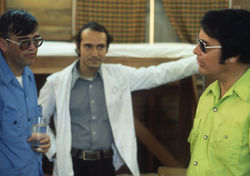“I am quite capable of organizing the suicide aspect + will follow through + try to convey concern + warmth throughout the ordeal.”
– Dr. Larry Schacht, in a letter to Jim Jones in Guyana, 1978

Photo courtesy of the California Historical Society
The doctor who masterminded the cyanide poisoning at Jonestown was Jewish.
The mandate to Jews in the Kabala is tikkun olam, “To heal and repair the world.” Before attending medical school, Larry Schacht wrote to Jim Jones that he hoped “to fulfill my goal to be of service to suffering humanity in the medical profession.” Dr. Schacht strayed so far from this mandate as to become the embodiment of all that stands opposed to this fundamental tenet of Judaism.
Robert Jay Lifton, himself a Jewish doctor, examined the paradox of doctors who harm instead of heal in The Nazi Doctors: Medical Killing and the Psychology of Genocide (1988). Lifton observed how, once given the opportunity, men of medicine – and the Nazi doctors he interviewed were exclusively male – moved easily from maintaining to violating their Hippocratic oath. As Hitler encouraged the use of human beings – primarily Jewish and Roma – for medical experiments, many doctors were eager to comply, often masking their sadism in the guise of advancing medical knowledge.
Schacht had no such guile. In his recent article, “Jonestown’s Medicine Man,” Craig Malisow of The Houston Press, writes, “‘Undetermined’ might be an apt descriptor for how Schacht, a middle-class, well-educated Jewish man from Houston, wound up in a secluded jungle compound, researching the most effective ways to slaughter men, women and children, in the first place.”
Also unlike the Nazi doctors discussed in Lifton’s disturbing book, Schacht went to his death along with his “subjects.” His body, like so many of the others, had deteriorated in Guyana’s intense tropical heat long before a meaningful autopsy could be performed a few weeks later in Delaware. The coroner’s conclusion, “undetermined,” failed to prove definitively that Schacht had indeed tasted his own medicine. The two who died by gunshot – Jim Jones and Annie Moore – clearly were not victims of the poisoned brew. By force or by choice, 907 human beings ingested Schacht’s lethal concoction on November 18, 1978, and it is probable he was one of the last to do so. As he had written earlier that year, it was likely he was there to “try to convey concern + warmth throughout the ordeal,” as he used a stethoscope to confirm death. The coldness of that facade of care mirrors his predecessors in the Nazi death camps.
By 1978, the details of the Holocaust were widely known. Not a child of survivors, like the Tropp siblings, Schacht apparently made no connections between the mass murders perpetrated by the einsatzgruppen and in the gas chambers of the extermination camps, and the mass murders of Jonestown. Thirty-three years after the liberation of Dachau, a Jewish doctor and his “research” caused the deaths of primarily African-American men, women and children, along with other whites, Jews, Native Americans in the biggest mass death of Americans in the twentieth century.
* * * * *
On the last day of Jonestown, Dick Tropp, one of the community’s chroniclers, wrote:
As I write these words, people are silently amassed, taking a quick potion, inducing sleep, relief. We are a long and suffering people. I wish I had time to put it all together—the meaning of a people—a struggle, to find the symbolic and eternal in this moment—I wish that I had done it. I did not do it. I failed.
Dick’s sister, Harriet, a P.R. person for Jones and Peoples Temple, summoned up the memory of the Warsaw Ghetto fighters when she compared the beleaguered – or so she believed – Jonestown members to those Jewish rebels who died trying to escape the fate the surrounding Nazi’s intended for them.
“This has been the unanimous vote of the collective community here in Guyana,” she told the world in a radio broadcast the previous spring as the leaders of Jonestown protested what they perceived was harassment of community residents by relatives and government agencies back in the United States. “We choose as our model, not those who marched submissively into gas ovens, but the valiant heroes who resisted in the Warsaw Ghetto.”
* * * * *
Sharon Amos, also Jewish, was the sole Temple member not living in Jonestown to obey the call to suicide. Though she was working for the Temple in Guyana’s capital of Georgetown with her three children, her spirit was with the mass murder occurring miles away, killing her two daughters and son before committing suicide. Not with poison, but a knife.
How did so many Jews fail to heed the Santayana quote posted above Jim Jones’s “throne” in Jonestown’s central gathering place, around which were heaped so many bodies? This photograph has become an iconic testament to our human failure to learn from the evils perpetrated in our collective history.
“Those who do not remember the past are condemned to repeat it.”
Jorge Agustín Nicolás Ruiz de Santayana y Borrás, known as George Santayana (d. 1952), penned those words in 1905, before the litany of horrors of the twentieth century began.
The “long and suffering people” to whom Schacht, the Tropps and Amos belonged – Jews – were familiar with such horrors long before World War I, the first attempted genocide of the century, of the Armenians by the Turks, and all the monstrosities of the 1900s which followed…
And yet…
No one learns from history. No one.
(Annie Dawid, author of three volumes of fiction, taught last summer at the Taos Summer Writers Conference and will be teaching at the Castle Rock (Colorado) Writers Conference in November. Her last book, Paradise Undone: A Novel of Jonestown, seeks a publisher. Her article about the book appears here. Her complete collection of articles in the jonestown report may be found here. She can be reached at annie@anniedawid.com.)